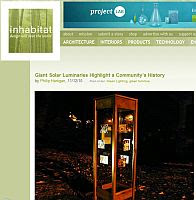(Apologies to email and Facebook friends who have already seen this).
A short article about the giant luminaries for the recently-completed Carroll County Community Memoir project has just been published in InHabitat, a great web magazine devoted to all things green in architetecture, design, art, technology.
http://inhabitat.com/2010/11/12/giant-solar-luminaries-highlight-a-communitys-history/
I've been following Inhabitat for nearly a year now, and it publishes information on the most amazing things. I guarantee that if you spend a few minutes reading its pages, you'll discover possibilities with sustainable design that you've never even dreamed of. The things that artists do, too, can be spectacular, so I'm quite chuffed, as we Anglos say, that the luminaries created by me, Michael Johnson, and Ryan Bess have been included.
 Subscribe to Praeterita in a reader
Subscribe to Praeterita in a reader
A short article about the giant luminaries for the recently-completed Carroll County Community Memoir project has just been published in InHabitat, a great web magazine devoted to all things green in architetecture, design, art, technology.
http://inhabitat.com/2010/11/12/giant-solar-luminaries-highlight-a-communitys-history/
I've been following Inhabitat for nearly a year now, and it publishes information on the most amazing things. I guarantee that if you spend a few minutes reading its pages, you'll discover possibilities with sustainable design that you've never even dreamed of. The things that artists do, too, can be spectacular, so I'm quite chuffed, as we Anglos say, that the luminaries created by me, Michael Johnson, and Ryan Bess have been included.
